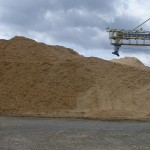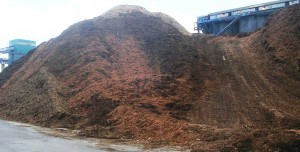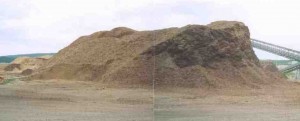Where any bulk, raw resource is used in an industrial process, there is a requirement to track both usage and inventory. And with the increased movement to utilizing biomass as a fuel source, more companies are discovering the difficulty in accurately measuring biomass inventory.
The traditional method of determining inventory has been to measure the volume of a pile and from that back-calculate the tonnage. However, accurately determining the amount of fibre in biomass piles has long been problematic and even today with accurate measuring devices, fibre measurement doesn’t have an easy solution.
 Pulp and paper mills everywhere have struggled with this problem for years. One year they will have to write-off wood chip inventory that appears to have disappeared; the next year they will have too much inventory. Other facilities that utilize biomass have similar inventory assessment problems.
Pulp and paper mills everywhere have struggled with this problem for years. One year they will have to write-off wood chip inventory that appears to have disappeared; the next year they will have too much inventory. Other facilities that utilize biomass have similar inventory assessment problems.
Volume Measurement
Pile size and volume is measured by surveying and years ago the lack of accuracy was accepted and used to explain inventory variances. With current measuring technology, the volume measurement accuracy has greatly improved and yet the estimate of actual fibre remaining in the pile is still not very accurate. Generally, the problem lies with not knowing the amount of compaction and the consequent density inside the pile. Without this knowledge, back-calculating tonnage from a volume measurement is quite `hit and miss’.
There are several methods of measuring pile volume, including LIDAR (light detecting and ranging) and non-LIDAR flyovers, ground GPS (global positioning system) survey and laser survey. Ground-based, 3D laser scanning likely provides the most accurate volume measurement for the cost.
`Rule of Thumb’ Conversion Factors
Most plants utilize arbitrary, `rule of thumb’ density conversion factors based on historical data to convert from volume to tonnage. Unfortunately, the characteristics of biomass can vary widely even within the same pile and no two piles will be the same, even if they are believed to be of the same material and constructed in the same manner. Utilizing `rule-of-thumb’ conversion factors will invariably lead to inventory errors. Any inventory method that is based upon volume (m³) or green tonnes (Gt) will not produce accurate results as neither reflect the true amount of fibre present. Chip flows and inventory should be tracked using mass in bone dry tonnes (BDt) only.
Compaction / Density
While volume can be accurately measured, there is no easy way of measuring compaction or density deep inside a pile. In fact, density varies throughout the pile and to accurately calculate the pile tonnage (BDt), you would need to have a 3D density profile and a complex algorithm to relate it to the volume.
 Density varies according to moisture content and degree of compaction. And, moisture content will change depending upon the climate, how long the chips are stored and the amount of compaction. Loosely compacted chips dry out faster.
Density varies according to moisture content and degree of compaction. And, moisture content will change depending upon the climate, how long the chips are stored and the amount of compaction. Loosely compacted chips dry out faster.
Compaction varies depending upon the size and depth of the pile, the size of the particles in the pile, and the type of dozer driving over the pile, if any. The larger and deeper the pile, the greater will be the natural compaction. The density near the pile edges will be significantly less than near the middle.
Because of their smaller tire footprint, rubber-tired vehicles compact the chips more than do tracked vehicles. Smaller particles compact differently than do larger particles, so particle segregation within a pile will result in different densities.
Particle size segregation naturally occurs as a pile is being built; larger particles tend to roll down the surface to the outer edges of the pile. Additionally, size segregation is greatly affected by wind, which will concentrate fine particles in one part of the pile. So, even if one were able to sample pile density, the results could vary significantly depending upon where in the pile the samples were taken.
Some studies have shown that the density deep inside a large pile can increase by 25-30% over the surface density and the overall pile density can increase by 14-15%.
Each pile is different and it is next to impossible to predict pile density with any accuracy based on historical data.
Pile Density Measurement
Nuclear depth density gauges are used successfully on large coal storage piles. This technique requires multiple bore holes into the pile into which plastic pipes are inserted and a nuclear density / moisture content gauge is lowered and measurements taken every couple of feet to make a 3D density and moisture map of the pile. This is a costly and time consuming process that is necessary if you are dealing with multiple 500,000 tonne piles of coal, but probably not economic on smaller biomass piles.
Losses Due to Biological Action and Spontaneous Combustion
Biological action within a biomass pile can result in fibre losses, which can have an effect on the fibre usage numbers. Some studies show that up to 1% of useful fibre can be lost per month of storage due to biological action, so this must be taken into account when rationalizing pile losses. Studies also show that the losses due to biological action are lower in highly compacted piles where the amount of oxygen is lower.
Pile turn-over has an effect on residence time and therefore on biological action. Few biomass piles are handled in a first-in, first-out (FIFO) manner and therefore residence time can vary greatly. Biological action is affected by the type and species of biomass being handled, moisture content and the amount of oxygen present.
Additionally, fibre loss can occur due to spontaneous combustion from biomass stored too long in a pile.
Multi-Pile Storage System
 If possible, use a multiple pile system where piles are routinely `zeroed-out’, or emptied completely several times a year; this way the inventory can be rationalized more frequently so that errors don’t accumulate. This also minimizes losses due to biological action and spontaneous combustion.
If possible, use a multiple pile system where piles are routinely `zeroed-out’, or emptied completely several times a year; this way the inventory can be rationalized more frequently so that errors don’t accumulate. This also minimizes losses due to biological action and spontaneous combustion.
Utilizing a multi-pile system sounds easy, but I know it is not always practical, particularly if the storage area is space-limited or if you are already dealing with multiple species in multiple piles. Pile management with odd-hour deliveries and multiple species blending can make fibre tracking a headache.
One option with multiple piles is to keep the pile-building function completely separate from the reclaiming function. That is, build a pile with a discrete amount of chips, then empty it. i.e. – don’t reclaim while the pile is being built and don’t add to the pile when it is being emptied. This system of pile management that utilizes discrete amounts of chips, keeps the in / out calculations simpler.
Accurately Determining the Amount of Fibre in a Pile
In light of the difficulty of determining pile density, how can one accurately determine the tonnage (BDt) of woody biomass contained within a pile? Following are some suggestions.
- Ensure frequent pile turn-over, to minimize losses due to biological action or spontaneous combustion.
- Utilize a multiple storage pile system.
- Do not track biomass inventory on a volumetric (m³) or green weight (Gt) basis, as neither reflect the true amount of fibre present.
- Do not rely on `rule of thumb’ conversion factors to convert between volume, wet weight and mass.
- Abandon the quest to determine compaction or an average density inside the pile. Unless you are going to measure the density of every pile, the result would be meaningless for subsequent pile inventory purposes.
- Rely on accurate measuring of the flows into and out of the chip pile. Utilize multiple, redundant scales on both the infeed and outfeed from a pile, so that malfunctioning scales can be quickly identified; and, recalibrate the scales at least twice per year, summer and winter.
- Measure the moisture content (MC) of both the incoming and outgoing biomass so that the BDt can be calculated from the Gt scale measurements.
- Track the tonnage in BDt rather than in Gt or in m³, neither of which remain constant.
- Moisture content can be measured by on-line moisture sensors or by lab analysis of chip samples from both incoming and outgoing chip flows.
- The amount of fibre remaining in a pile (BDt) at any one time would be the difference between the incoming and outgoing amounts.
Determining Average Pile Compaction / Density
If one really needs to determine the average amount of compaction or average density of a pile of chips, you could do so by adding a survey step into the above procedure:
- Build the pile in the normal way.
- Stop the feed onto the pile and the reclaim from the pile.
- Survey the pile to determine the volume before reclaiming the pile.
- Reclaim and measure the Gt and MC of the outgoing fibre and calculate the BDt.
- Take frequent samples of the reclaimed biomass and calculate the loose density (BDt/m³) of the samples per established lab procedures.
- Empty the pile completely.
- Divide the total outgoing tonnage (BDt) by the surveyed volume (m³) to get the average pile density (BDt/m³). And, compare this density to the lab sample density to calculate the amount of compaction.
About the Author
Paul Janzé has more than 30 years experience in engineering design, project management, equipment manufacturing and maintenance, primarily in the forest products and energy industries. His material handling experience includes: biomass handling and processing including forest residuals, logs, lumber, chips, woodwaste, pellets, straw and poultry litter, animal tissue, sludge and biosolids; municipal solid waste (MSW); lime dust, coal and ash handling.
He has a keen interest in technologies which recover and utilize waste materials and convert them into products such as wood pellets. Paul’s specialties are fibre flow analysis and mass balances, process optimization and designing novel solutions to complex processing and handling problems.
For other articles related to biomass processing and handling, go to Paul’s website at www.advancedbiomass.com

You mentioned above that Nuclear depth density gauges are used successfully on large coal storage piles. Would using this gauge be effective on large hog fuel piles even though the cost is high? Is there a source that you have that will provide this service?
Hi Joshua,
Thanks for visting my website.
I don’t know why a nuclear depth / density would not work on large hog fuel piles, but unfortunately I don’t know of anyone who has actually tried it. Nor do I know who might provide the service.
Paul
“Some studies have shown that the density deep inside a large pile can increase by 25-30% over the surface density and the overall pile density can increase by 14-15%”. Hi Paul, thank you for providing this practical information freely. I wondered if you could send me the source for the information regarding the density changes you quote?
Thanks so much,
Shannon
Hi Shannon,
Thanks for visiting my website. I apologize for not having that information readily available. I can see that I am going to have to do a better job of filing my research information with the articles I write, so that I can readily access them. I still have a couple of boxes of data to go through and will continue to look.
Paul
With respect to nuclear density gauges the wet density of the pile could be captured but the water content and calculated dry density will be skewed due to the organics in the pile. A representative sample of the material tested with the nuclear gauge would have to be recovered and lab tested for water content. Then you should be able to calculate a reasonable accurate dry density. It may not be practical to measure density on an on-going basis with this technology.
Hi Paul,
I was just wondering if you ever came across references for the changes in chip pile compaction given above? There are various compaction factors being applied by pulp companies I work with, some are fairly complex, but all are used in an attempt to arrive at an accurate chip pile mass from the volume measurement. The source for these values seem to have been lost as time passes. Anyways, I am always on the look-out for this information.
Thanks for any help you are able to provide.
Shannon
I am building inspector doing Fire Safety inspections. We have several Hog pile operations in Pasco WA. I am determining some important quantifiers for the companies. The IFC requires a static temperature reading be sent to the code official each week. It calls for the BO to set the high temperature limit. The code also states that a fire hose be provided to reach each end of the allowed 250 foot long pile with water. Do you know what common GPM is used by most managers?
Terris,
Thanks for visiting my website. The amount of water required depends entirely upon the anticipated largest fire that you would be expected to extinguish. I don’t know of any common numbers; however, I do know that 8″-10″ underground fire mains around biomass piles are not uncommon. I would think that your local fire marshal would be better able to provide you with information, than I.
Paul
Great web site and information — wow…. I will send to all of my folks working in bioenergy files…. Kudos to you Paul
Dear Mr. Bozic,
Thank you for visiting my website, http://www.advancedbiomass.com , and I am glad that you enjoyed the articles. And, thank you for referencing my site to your people.
I am very interested in working with your team on any wood and biomass handling projects that you might be considering. I have done many projects in northern Alberta over the years and I am aware of the challenges of working with biomass in extreme cold climates.
I am available anytime for a teleconference to discuss how I might contribute and participate.
Paul
Paul Janze
Advanced Biomass Consulting Inc.
Langley, BC Canada
1-604-505-5857
pjanze@advancedbiomass.com
http://www.advancedbiomass.com
Hello Paul,
First of all, I’d like to congratulate you on the excellent article.
The Brazilian company that I work for is a specialist in inventory and we use to measure grains, sugarcane piles, etc…, using a 3D laser scanning to determinate the volume and laboratory analyses to determine density, compaction, etc….
Last week we receive a quotation from an important sugarcane and Ethanol producer to inventory its sugarcane bagasse (biomass) and it has become a big challenger for us.
As you explain brightly in your article, the problem is how to determine density at different pile areas and guarantee the accuracy requested by the client.
As the article was written in 2011, I’d like to know if exists nowadays a method or equipment which becomes this process more simple, fast and secure.
Thank you in advance for any help with this issue.
Best Regards,
Nivaldo Lopes